
Ski Tips: Deceleration lives in the future
January 11, 2021
By Dan Egan, EBS ski columnist
Many skiers try to slow down each turn they make because they are living under the delusion that the purpose of turning is to slow down. Skis are not designed to slow down. I’ve never met a ski engineer that has designed a ski to go slow. Skis are designed to make a predetermined radius of a turn, and to accelerate. Each company has its theory of what materials make up the best flexing ski both tip to tail and torsional. Some are softer to absorb the energy created—they flex and dampen, which allows them to slow down easier. Others, like race skis, are stiff for pure acceleration. The wider skis these days are really fast because of the increased surface area—the ski floats and glides forward free of the friction of being down in the snow.
If you turn with the purpose of slowing down every turn, my guess is your legs feel tired by mid-morning or midday, and because you are skiing slow and making short turns, you are overturning during your descent. Not only is this not efficient, but it is also exhausting.
Deceleration lives in the future. It is too late to slow down in the turn you are making, and here’s why: when a skier attempts to slow down at the end of their turn by pushing or bracing against the downhill ski, this action stiffens the ankle, knee and hip causing the ski to skid and puts the skier out of balance. If you do this every turn, you’ll never gain balance, flow or efficiency.
So how do we slow down the technology we have invested in? I spend a lot of time in my camps and clinics convincing skiers that with a slight increase in speed and a mapped-out route, you can ski efficiently, save energy and have more control. The end result will be a longer more enjoyable ski day and eventually you will expand your mastery of the mountain.
Slowing down is an intentional strategic move while skiing, and the how, where and when is an important decision made in advance of a run. I start each run with an intentional plan and break it down into sections. That way I know where I am starting, where I am going and where I will stop. Once I determine the different sections of the route, I then look for deceleration points along the way of each section. Sometimes it can be pillows of fresh snow, or in moguls, the top and downhill side of bumps, or I search for plateaus that make a good target to aim at and longer slower arcs.
The key is to not slow down every turn, rather, I’ll ski three or four turns, letting the skis flow down the fall line and then slow down over a series of turns. I call these turns my “slowing turns.” In other words, I’ll ski three or four turns, then make three “slowing turns”, that are slow, slower and slowest. At that point I’ll either stop, regroup and go again, or I’ll carry one with another sequence of three to four turns in the fall line and then make my “slowing turns”—slow, slower and slowest and stop.
This is what I mean when I say deceleration lives in the future, if you want to slow down, turn. When you release the built-up energy of a turning ski and enter into the new turn, you are gaining control and can slow down while remaining in balance.
You can experiment with this on different slope angles. Start on your favorite blue groomer run and then once you feel comfortable venture out onto a steep pitch, or off in the trees and or powder.
It is important to remember when I make my series of “slowing turns” I compress and extend more—I’m not static. The more I move up and down the more I am able to control the pacing of my skis and control the speed.
The “slowing turns” commit skiers to slowing down in the future, because they release the turn they are in, enter into the new turn with more motion, which absorbs energy, and as control is gained speed is dissipated over a series of turns.
So as a review, map out your run, ski it in sections. Tell yourself, decelerations lives in the future and that it is too late to slow down in the turn you are making. Then head off down the slow, turn in the fall line and as you enter into one of your planed areas to slow down, make your three “slowing turns”—slow, slower, slowest. Stop, smile and continue.

Extreme Skiing Pioneer, Dan Egan coaches and teaches at Big Sky Resort during the winter. His steep camps run Feb. 25-27, March 4-6 and March 11-13. He is newest book, Thirty Years in a White Haze will be released in February, for pre-orders visit www.White-Haze.com for autographed copies.
Posted from Explore Big Sky via Facebook



